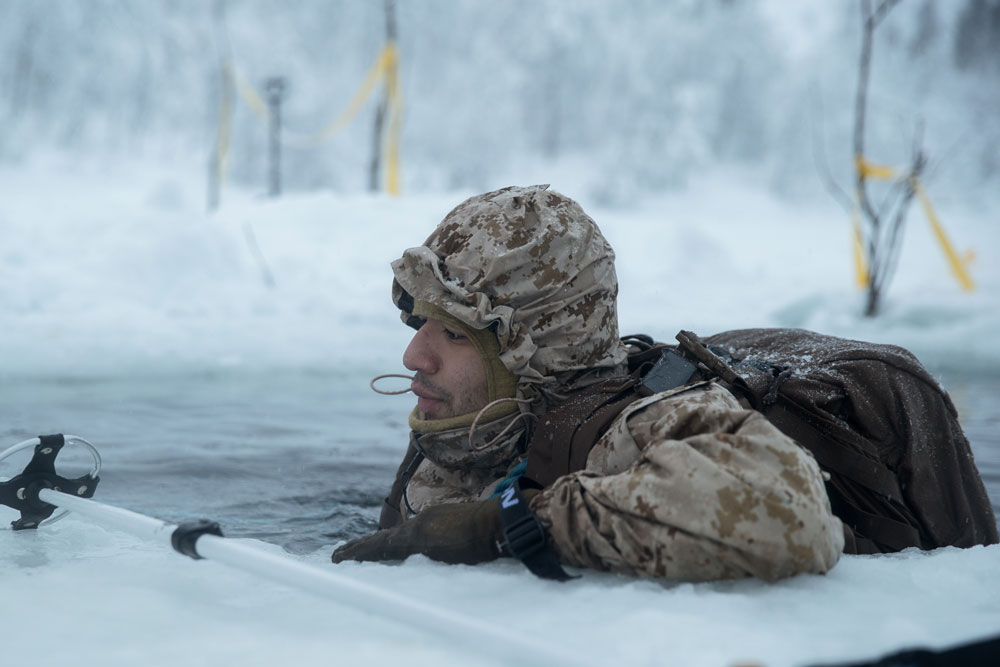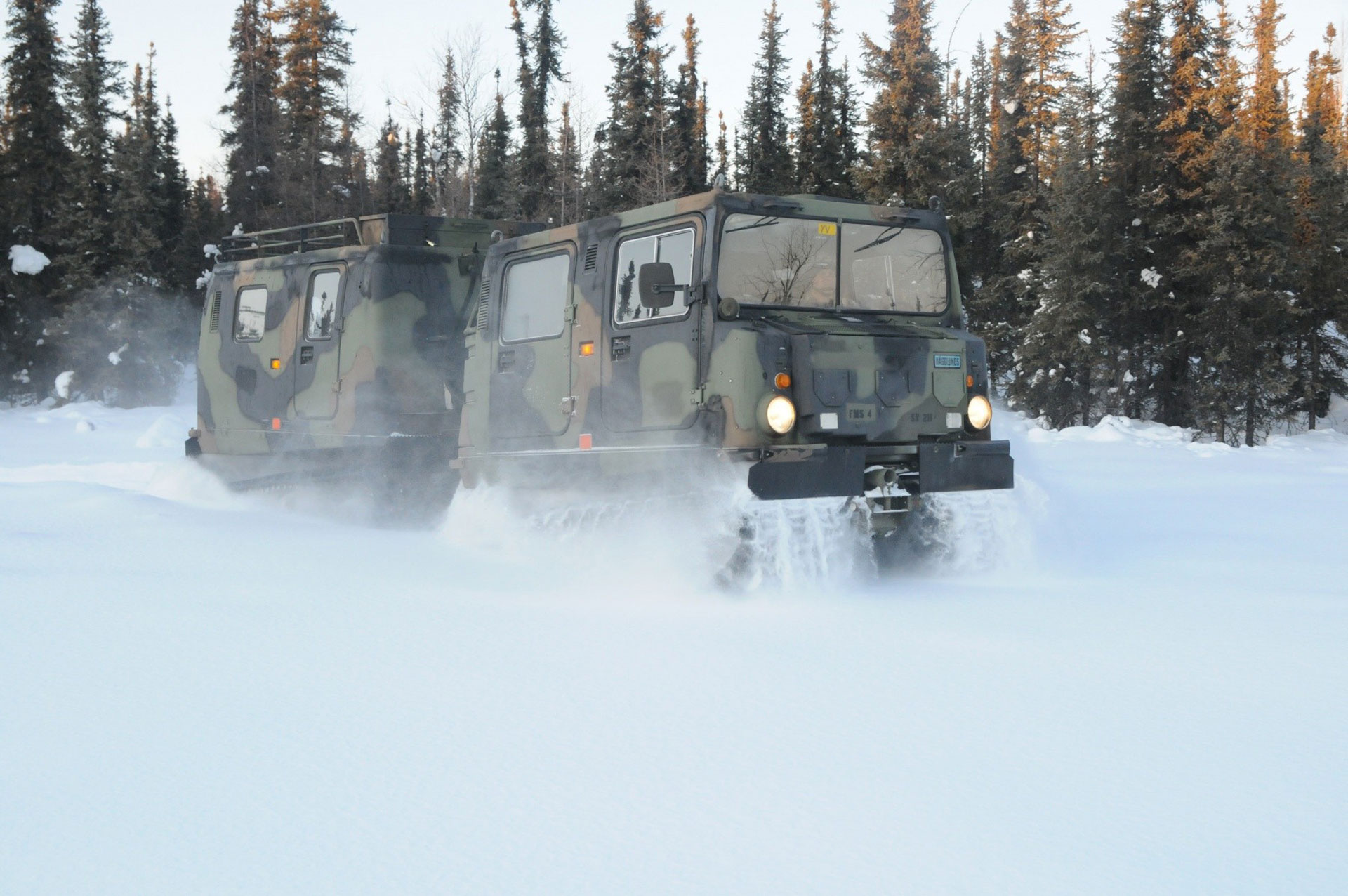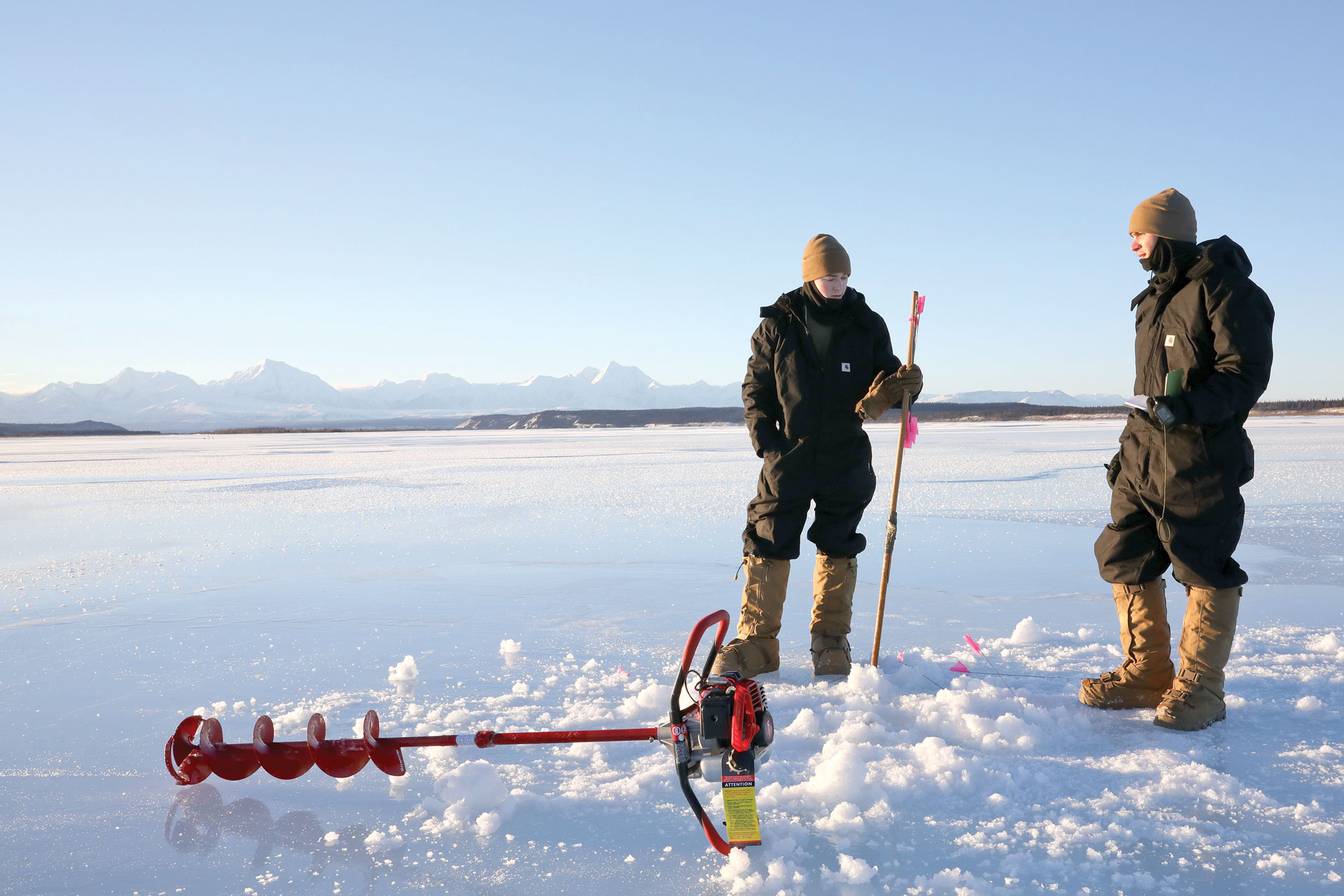
AN ARCTIC HIKE: U.S. Marines with Marine Rotational Force – Europe 20.2, Marine Forces Europe and Africa, observe the mountain ranges to identify the next destination during a Narvik Battle Study Hike in Setermoen, Norway, Sept. 17, 2020. MRF-E conducts various exercises including arctic cold-weather and mountain-warfare training, as well as military-to-military engagements throughout Europe that enhance cooperation among partners and allies. (Photo by Sgt. Abrey Liggins, U.S. Marine Corps)
U.S. leaders focus on the Arctic.
By Ellen Summey
The Arctic has long served as a protective barrier for North America—a cold and nearly impenetrable wall that required little active defense. As climate change makes the region more easily accessible, the nations of the Arctic are reckoning with the new and increasing possibility of adversarial military activity in their northernmost territories. For the United States, which in recent years has focused much of its military resources on conflicts throughout the Middle East and South Asia, military leaders have decided it’s time to reassess their cold-weather capabilities.

A CHILLING EXPERIENCE: A U.S. Marine with Marine Rotational Force-Europe 19.1 remains calm to prevent hypothermia during an ice-breaking drill as part of Exercise White Ulfberht in Setermoen, Norway, Jan. 22, 2019. Marines with Marine Rotational Force-Europe were exposed to freezing water to test their ability to use proper methods to get out of water in case of breaking ice. (Photo by Cpl. Nghia Tran, U.S. Marine Corps)
The Army’s new Arctic strategy, released March 16, outlines the branch’s commitment to regaining dominance in the far north. This heightened focus on cold-weather capabilities will also necessitate materiel solutions for Soldiers in the region—the tools, equipment, training and infrastructure to enable rapid and sustained operations at temperatures as cold as -65 degrees Fahrenheit. “The Arctic is an opportunity to rapidly employ the speed, range and convergence of cutting-edge technologies being developed for multi-domain operations to strengthen our deterrence capabilities in the region,” said Gen. James McConville, Chief of Staff of the Army.
“For a couple of decades, we’ve been meeting significant demands around the world—to a degree, it’s taken its toll,” said Maj. Gen. Peter Andrysiak, commanding general of U.S. Army Alaska, speaking at an October 2020 virtual meeting of the Alaska Federation of Natives. “There is a realization that we’ve got to slow things down and refocus. We are going to focus to rebuild the skills that we have lost over the years.” Andrysiak said time is of the essence, and he’s not alone in that assessment.

EXERCISES ON ICE: U.S. Marines with Marine Rotational Force-Europe 20.1, Marine Forces Europe and Africa, conduct a hike during cold-weather training in Setermoen, Norway, Nov 26, 2019. Marine Rotational Force-Europe conducts various exercises, arctic cold-weather and mountain-warfare training, and military-to-military engagements, which enhance overall interoperability of the U.S. Marine Corps with allies and partners. (Photo by Cpl. Brennon A. Taylor, U.S. Marine Corps)
“It’s clear to me, there is a quickening in the Arctic,” said Michael Sfraga, director of the Polar Institute and the Global Risk and Resilience Program, during a December 2020 Wilson Center virtual panel discussion about the Army’s efforts to define its own Arctic strategy. “Whether it be the changing physical landscape, the evolving geopolitical landscape, the promise of increased development and increased commerce, or the growing interest from our non-Arctic nations, it is clear the Arctic is not what it used to be.”

COOL NEW TOYS: A Small Unit Support Vehicle drives through the Yukon Training Area on Eielson Air Force Base, Feb. 27, as part of exercise Arctic Eagle 2020. The 2021 defense spending bill said “The committee encourages the Secretary of the Army to pursue equipment and vehicles necessary for Arctic and cold weather environments.” (Photo by Spc. Kyle Odum)
Lt. Gen. William B. Garrett III (USA, Ret.) former deputy commander of U.S. European Command, also a panelist for the Wilson Center discussion, said the Army must prepare itself for large-scale operations in the Arctic. “We have to deal with the world as it is, and that means preparing for great power competition with China, and to a lesser extent, with Russia. The Arctic region is an extension of that competition, even as the security environment in the Arctic is being fundamentally altered by the impact of climate change.”

What is the Army’s role in this unique environment? “As a force organized, trained and equipped for land warfare, the Army must adapt and change to be relevant in the Arctic,” Garrett said. “Success requires adapting existing capabilities and, where necessary, selectively acquiring new capabilities, combined with Arctic-specific training, exercises and posture refinements.”

ICE BRIDGE: Paratrooper engineers with 25th Infantry Division use an auger to drill a hole in river ice as they prepare to construct a bridge across the Tanana River at Donnelley Training Area, Alaska, in January. The paratroopers are constructing the bridge in preparation for exercise Arctic Warrior 21. (Photo by Staff Sgt. Alex Skripnichuk, 4th Brigade Combat Team, 25th Infantry Division Public Affairs)
And as the U.S. reprioritizes its Arctic capabilities during this time of rapid change, it must work in concert with its allies around the world. “The United States’ greatest strategic advantage in the Arctic is our strong relationship with Arctic allies and partners,” said U.S. Coast Guard Capt. Tom D’Arcy, U.S. European Command’s Strategic Division Arctic branch chief. “This is something our competitors do not possess. Our network of relationships and capabilities serve as a deterrent helping to deter malign activities in the region.”

GET FROSTY: Command Sgt. Maj. Allen Mortenson 25th Infantry Divisions “Spartan Brigade” checks his equipment before moving to the assembly area after an airborne operation to kick off Exercise Arctic Warrior 21 on Feb. 8 at Donnelly Training Area, Alaska. The Spartan Brigade is the only airborne infantry brigade combat team in the Arctic and Pacific theaters, providing the combatant commander with the unique capability to project an expeditionary force by air. (Photo by Maj. Jason Welch, 4th Brigade Combat Team, 25th Infantry Division Public Affairs)
This sidebar is accompanies the article “COOL UNDER PRESSURE” published in the Spring 2021 issue of Army AL&T magazine. Subscribe to Army AL&T – the premier source of Army acquisition news and information.
![]()







